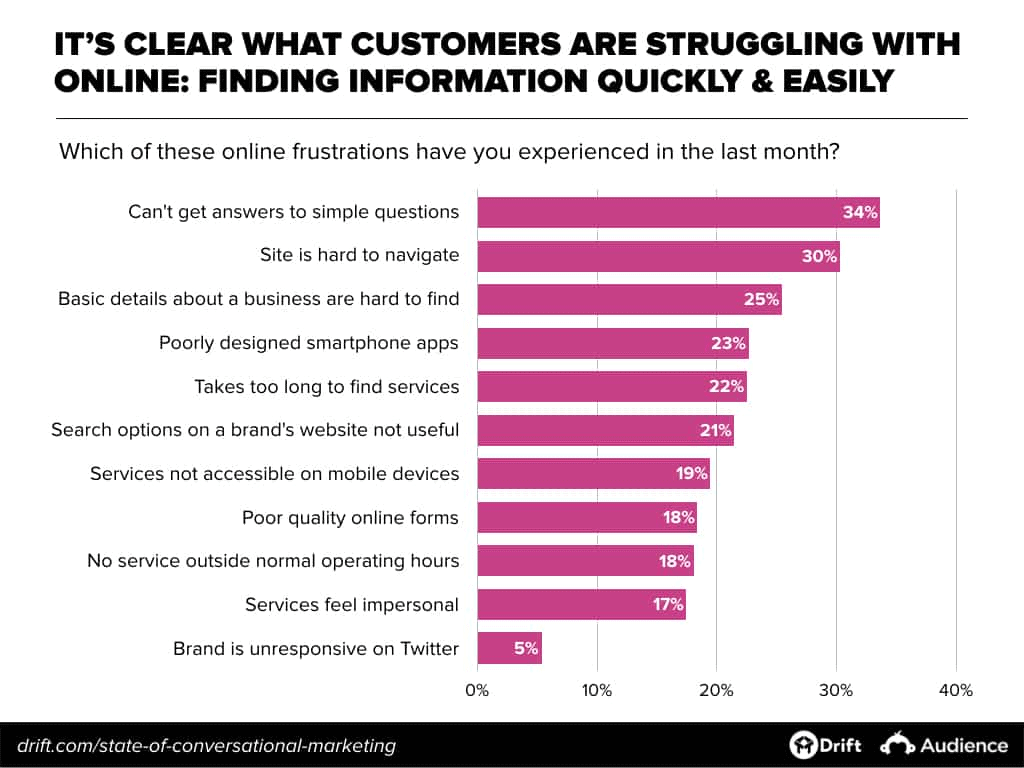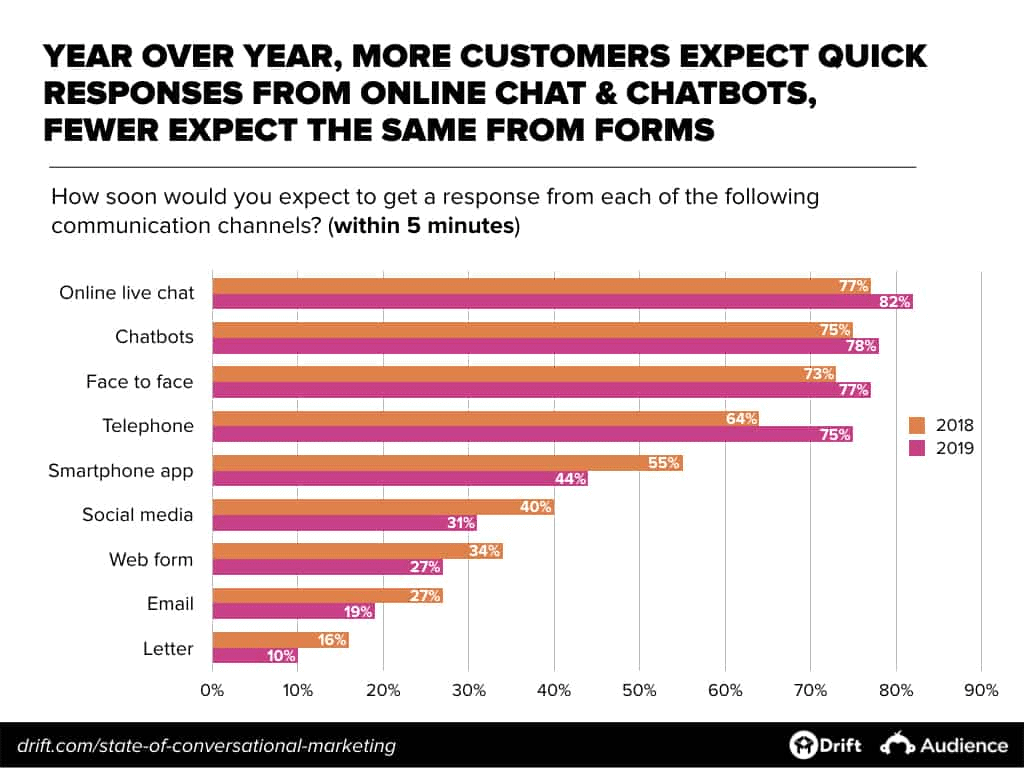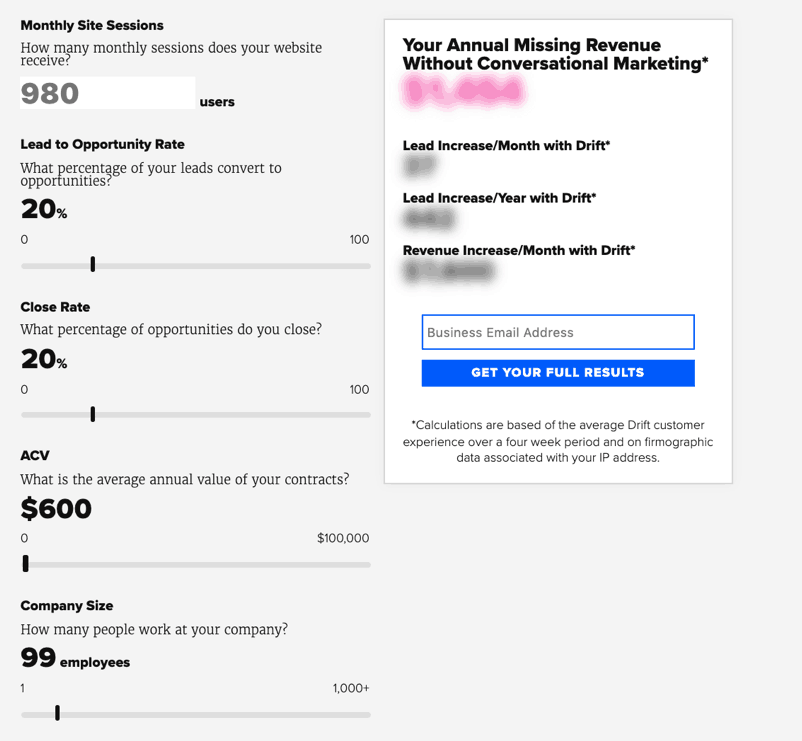
Let’s get one thing straight. People are used to having their needs met and questions answered – immediately. But here’s a little known secret. If you can actually answer your buyers’ questions at the moment they have them, not only can you book a meeting (or even make a sale), you can also improve your SEO ?
Yes, you read that right. One of the most effective, yet underutilized marketing strategies is combining conversational marketing and SEO. It’s the perfect one-two punch.
It works because you’re providing a fast and efficient way to move customers through the whole sales process – all while making sure you stay in Google’s good graces. And in the end, you and your customers will be much more satisfied with the experience and your website should rank better (or at least more consistently).
Intrigued? In this post, I’ll walk you through some basics and then tell you exactly how you can incorporate conversational marketing into your content marketing and SEO efforts.
What Is Conversational Marketing?
Conversational marketing is a way to quickly engage with your website visitors and leads with real-time conversations.
It’s a form of inbound marketing that places more importance on the actual online engagement with a prospective customer.
Why do these online engagements matter?
Because buyers will have questions about your product or service, as well as your business and who you are. And we all know that asking questions through a contact form or phone call can lead to frustrating games of tag. No one wants that (or has the patience for it anymore).
Conversational marketing uses things like intelligent chatbots to answer questions and help customers in real-time.
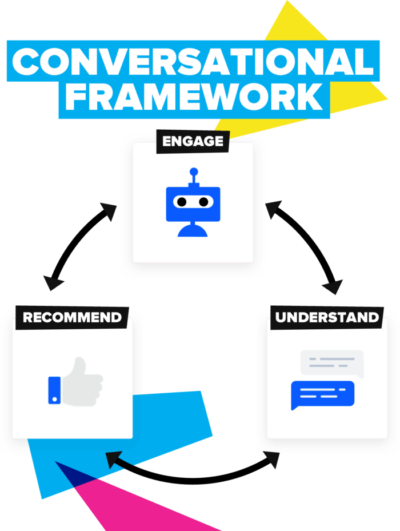
Bots can answer the basic questions you get asked the most and act as guides that direct buyers where they want or need to go.
Here are other examples of conversational marketing.
Benefits of Conversational Marketing
So why use conversational marketing in your business?
- It saves a lot of time by answering common buyer questions for you
- It also helps provide fast, real-time engagement that will satisfy the vast majority of customer questions and concerns
- And for the more complicated issues that can be raised, bots are programmed to route in the right person to answer the question or provide a solution
Buyers get the answers they’re looking for right away. And when you’re spending less time answering direct, one-off questions, you can focus on more complicated problems (not to mention improving and maintaining your customer success metrics).

Everyone winds up happier than they would be with a more traditional process that involves lengthy forms and a whole lot of waiting.
Conversational Marketing Statistics
Want even more proof about how effective conversational marketing can be?
Here are some eye-opening statistics from surveys conducted with real customers who used it ?
Finding information (quickly & easily)
First, let’s talk about the problems that businesses face when they try researching a product, service, or business online.
The most common issues have to do with finding answers and information. It could be basic information like a store’s address that they can’t find. Or they’re frustrated navigating the website to find the right product they want.
This is what has driven a big change in customer preferences when browsing online.
In the past, consumers were hesitant or even hostile to chatbots. Part of that is because they weren’t as intelligent originally. But part of it was distrust interacting with anything but a real human being able to help them.
Now, only 14% of consumers who were surveyed said they preferred filling out a form to engaging with a chatbot.
In the graph above, you can see how buyers now expect it to take much longer to get a response from an email, online form, or phone call compared to chats.
It’s what customers expect to see
All of these statistics are showing how people want faster responses.
Now that they’re realizing how fast and efficient live chat and chatbots are, buyers trusting them more. As this trend continues, I’m confident you won’t be able to have a website without conversational marketing.
It will be like if you had a business now – but without a website ?
How to Use Conversational Marketing with Content & SEO
If you’re sold on the general idea of combining conversational marketing with SEO, here’s how to get started.
This section will run through some actionable ways you can combine conversational marketing with SEO.
Ready? Let’s go.
Add value to products and services
Your products and services pages are arguably the most important for driving your business. After all, they are your money makers.
But it’s also where you will get a lot of questions from potential customers. This is the perfect opportunity to leverage conversational marketing to add more value to these pages.
If you are going to follow one customer experience trend, this is it.
The goal should be educating potential customers and engaging with them in ways that will help them convert into paying customers.
Here are some examples of things a customer might ask about before they convert:
- Product or service details – does your B2B service or product have additional information that your client might want to know?
- Pricing – do you offer pricing tiers to suit different sized businesses, from small businesses to enterprise solutions?
- Customer support – do you offer any training, QA, or additional onboarding and support to your business clients to help them learn how to use your product or service?
Most of these sorts of questions have easy and quick answers. Conversational marketing helps give you a way to provide immediate responses so your buyers are satisfied. That way. they finish submitting an order or appointment request.
But here’s how to take it a step further. This also gives you a great opportunity to support your content about your products and services – and any SEO efforts you put towards them.
You don’t have to cram too much information onto one page. You can also improve the navigation of your site so it’s easier for customers to find more information if they need it.
Provide 24/7 customer support
When it comes to product marketing, customer support is key.
This is true for service-based businesses, but is especially helpful for businesses that sell any kind of product – be it something tangible or something like software.
People will inevitably run into issues when it comes to using your product and they will come to you with help.
In fact, 89% of customers have switched to a competitor following poor support.
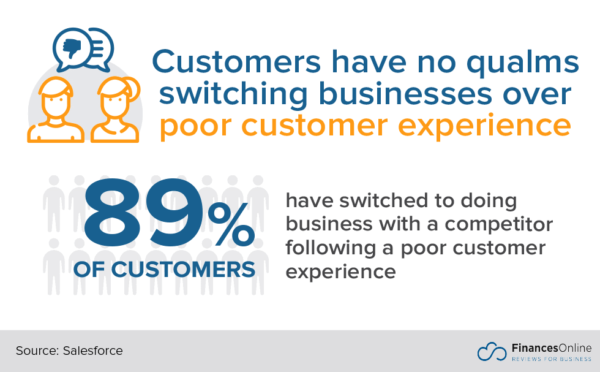
Image Source
Here are some of the ways that conversational marketing can help provide customer support:
- Shipping issues – send tracking numbers, check for delays, update order status, troubleshoot shipping issues
- Functionality questions – provide basic explanations or resources to help a customer figure out how to use a product
- Troubleshooting – diagnose and fix basic issues with why a product is not working as it should be
- Warranty information – answer questions about if a product defect is covered by warranty, and begin basic requests for warranty claim
- Return requests – begin processing return requests
This can be an especially frustrating time for customers to go through any delay in receiving a response.
That’s why you can set up conversational marketing on a customer support section of your website. With automated chatbots, you can provide first-level support around the clock instead of employing a team to cover every hour of the day.
You can also use these tools to direct customers to resources to help them solve their problems. If there’s a common issue with a product or a question about warranties, the chatbot can direct them to the right solution.
It can greatly improve the SEO of all your customer support-related content by collecting the FAQs your customers have and then mapping that to keywords they search for.
Improve dwell time (aka how long people stay on your site)
One of the important factors for SEO, user experience and improved visitor retention on your website is how long they stay on your site.
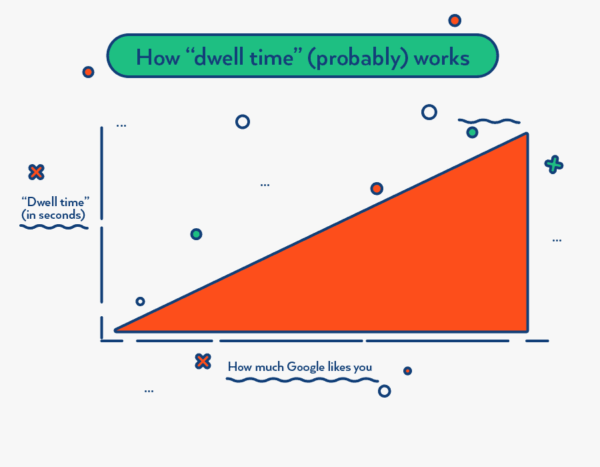
Image Source
Basically, the longer someone is on your website the better for your rankings. On the other side of that coin, if they leave very quickly it can hurt your rankings.
If it’s frustrating for them to find any answer to their basic question after they land on a page, they’ll leave. Conversational marketing presents a big opportunity to improve the length of time a customer spends on your site.
Here’s how you can make it work for you:
- Link to related pages if they don’t find the answer to their questions in the content they’re reading
- Keep them on the same page longer as they interact with the chat
- Automate scripting related to specific content pages or hubs to be more personalized and engaging
Having conversational marketing set up on your website will help customers linger longer after they read your content. This will inevitably increase the time they spend on the page, and on your website overall ⏰
Boost customer engagement
A user’s engagement with a website is considered an important SEO ranking factor.
When you consider that 93% of online experiences start with a search engine, that’s a lot of users to potentially engage with.

Image Source
More specifically, user engagement includes time on site as mentioned above. But it also includes specific measures of actual engagement, such as bounce rate and multiple page views.
Basically, when someone clicks on a link, plays a video, or visits multiple pages it signals to Google that they engaged with your content.
If someone engages with your content, it tells Google that they were interested in it enough in it to act. On the other hand, if they just passively read it and then leave, it can be a sign that they didn’t like it.
Your conversational marketing can help them engage with your content more to improve your SEO.
Here’s how:
- Interactive tours – give them a tour of your website to find related content so they click on more pages
- Tools and resources – give them an interactive tool or resource to get more information on pricing, designs, “build your own product,” and so on
- Product demonstration – demonstrate how a product works with interactive elements
- Calls to action – use an effective call to action that entices a user to engage in a specific, personalized way
These tools give attractive options that a customer is more likely to engage with. One good example of an interactive tool is Drift’s conversion rate calculator:
They help drive them to specific content that they would be interested in, which helps the SEO for those pages as well. It’s just another tool to drive more and better quality engagement with your website.
Collect user data (to create content people want to read)
Arguably the best way to improve the content on your website is through customer feedback – aka to hear the issues from customers – and then act on it.
If there’s something that’s missing, not clear or not working, your customers will let you know if you make it easy for them to do so. Having a chatbot on the page asking them how you can help is the best way to do it.
Basically, by talking (and listening) to your customers, you can understand their problems and then fix them. Or at least answer them better with your content. Companies that use customer feedback can help improve customer satisfaction and help lower churn.
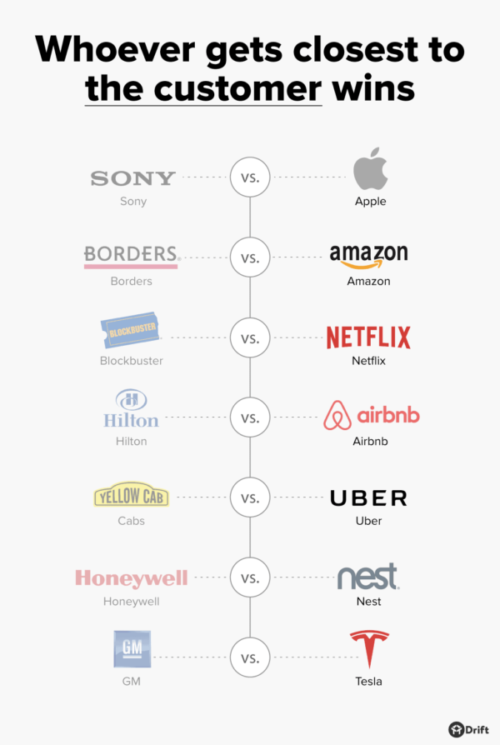
You’ll find that some pages get more chats more than others. Or, you’ll find some specific questions or issues get raised suddenly, for example when a customer complains about the following:
- Navigation – they can’t find the information on your website that they’re looking for
- Information – your page is not answering everything they want to know
- Technical issues – part or all of your website is not working properly
The user behavior data you gain from how, where, and when they use the chat will help you improve your content.
Take the questions that get asked the most and add an FAQ that gives quick and basic answers. Fix the navigation or technical issues so they can find the content they want to read.
Update a page so it makes the information clear and easy to read, and fully answers any questions they might have.
You can even combine this user data with keyword data from doing a competitor gap analysis to help you target customer-focused, traffic-driving keywords.
Wrapping Up
Conversational marketing can be a game-changer for your website’s content and SEO strategy.
You can use it to help people navigate your website and find what they are looking for without any delays. Plus, it improves the user experience, so your buyers can get the information they’re looking for without having to wait.
Here’s a quick recap to close things out. Conversational marketing can help you:
- Provide quick customer support that provides them with immediate answers and resolutions to basic problems
- Understand valuable data insights on customer behavior so you can improve your content
- Increase user engagement to improve your SEO signals to Google
Like I said at the beginning of this post. Combing the power of conversational marketing and SEO is a one-two punch. Are you ready to try it?
Adam Steele is the Founder and COO at Loganix, an SEO fulfillment partner for agencies and marketers. We build easy to use SEO services that help businesses scale. If you liked this article, please check out our SEO guides and templates on the blog.




